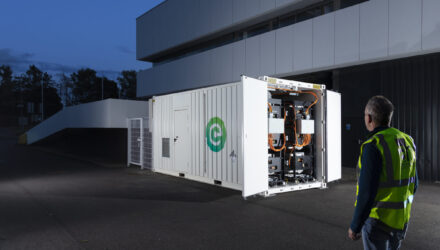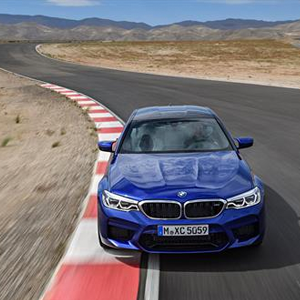
The BMW M5 is the original model that started the high performance super saloon genre. Now an all-new sixth generation of the BMW M5 Saloon, will launch in February 2018 equipped with an enhanced V8 engine, a new M-specific, all-wheel drive system known as M xDrive and performance statistics that surpass all previous incarnations.
Key to this heightened level of performance is the introduction of M xDrive and its adaptability thanks to a central control module and the variety of different dynamic modes that can be selected. When first started, the car is in four-wheel-drive mode with the Dynamic Stability Control (DSC) switched on. But it comes with various driving dynamics modes, up to a track-friendly pure rear-wheel drive without DSC.
Power comes from the latest 4.4-litre V8 engine with BMW M TwinPower Turbo technology. It delivers a maximum torque of 750Nm, accelerating the new M5 from zero to 62mph in just 3.4 seconds, making it the fastest M5 yet. Power is transferred to the road via a new eight-speed M Steptronic transmission with Drivelogic.
All of this performance is wrapped in a design that adheres to the form follows function mantra of all BMWs. The front design serves to splice the oncoming air in the most aerodynamic fashion while at the same time providing the breathing and cooling requirements for a 600hp engine and its braking system, and the downforce required of a high performance saloon.
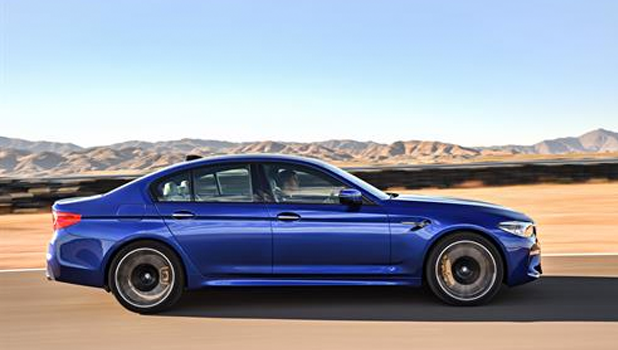
Engines and Transmission
Thanks to various tuning enhancements, the latest BMW M5’s 4.4-litre V8 M TwinPower Turbo is more powerful than ever. It develops a maximum torque of 750Nm from just 1,800rpm through to 5,600rpm – a 70Nm increase over the previous M5.
The engine characteristics can be changed by pushing the Drive Performance from the basic setting ‘Efficient’ to ‘Sport’ and ‘Sport Plus’, both of which provide a faster turbo response.
BMW’s M engineers have developed new turbochargers and a higher injection pressure of up to 350bar. This allows shorter injection times and better fuel atomisation, making it both faster and more efficient.
Improved lubrication and cooling systems include an oil pan with a small front silencer and an indirect charge air cooler, which is more powerful than its predecessor, despite its smaller size. The oil supply, which is operated by a variable pump, is designed for racing track applications and allows high G acceleration with no risk of oil starvation.
The exhaust manifolds have also been modified to ensure the best transfer of exhaust gas energy into the two turbochargers. Through the use of a resonator between the two rear silencers, the M engineers have also reduced the car’s mass. The exhaust note is flap-controlled and is influenced by the different driving modes to enhance the driving experience further. An M Sound Control button allows the driver to reduce noise levels at the push of a button.
Power is transmitted to the road via the newly developed M xDrive all-wheel drive system. M xDrive brings the front wheels into play only when the rear wheels reach their limits of adhesion.
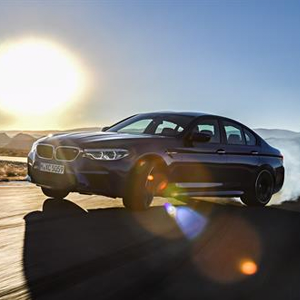
The main components of M xDrive are based on the intelligent all-wheel drive BMW xDrive system and Active M differential, controlled by a central M-specific vehicle dynamics control system. The drivetrain is stiffer and stronger than the previous model, while the transfer case constantly controls the torque distribution between the front and rear axles. The Active M differential splits distribution of the drive between the rear wheels. With M xDrive, the DSC intervenes only when necessary in extreme situations, so that the high engine power can be converted almost without power loss.
Enthusiastic drivers can configure M xDrive at any time according to their needs. In the default setting with DSC and 4WD switched on, the new M5 is similar to the typical M rear-wheel drive dynamic characteristics when accelerating out of a corner. At the same time, the car remains forgiving. The superior traction of the all-wheel drive system also provides impressive acceleration values from zero to 62mph in just 3.4 seconds and zero to 124mph in just 11.1 seconds.
If the driver switches to M Dynamic mode (MDM, 4WD Sport), the M5 becomes sharper and more agile. More torque is fed to the rear axle and the rear wheels give more wheel slippage. This allows controlled drifts and playful handling, but with controlled oversteer.
The pure rear-wheel-drive 2WD mode is designed for track use by experienced drivers and is dedicated entirely to pure driving pleasure without restrictive control systems.
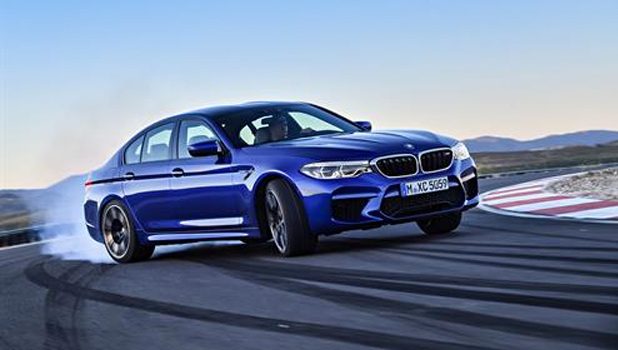
The new eight-speed M Steptronic transmission with Drivelogic has extremely quick shift times and optimises change points to deliver the best performance. Thanks to a higher final drive ratio, the eight-speed M Steptronic transmission also delivers reduced fuel consumption.
It allows fully automatic shifting in “D” mode and sequential switching in “S” mode. This is possible both with the new short gear selection switch on the centre console as well as via M-shift paddles on the steering wheel.
The shift characteristics of the gearbox can be changed via the Drivelogic gear shift lever on the gear selector. Drivelogic Mode 1 stands for efficient driving with comfort shift times. Mode 2 supports fast driving with shortened shift times. Mode 3 is optimised for track driving with extremely short shift times. Those who prefer manual shifting in “S” mode can also make multiple downshifts to the lowest possible gear, for example when braking into tight corners. An integrated oil cooler ensures the gearbox is protected even when used on the racetrack.
Superior chassis technology – A new era of driving dynamics.
BMW’s M engineers made great driving dynamics and the best possible stability their goal in the chassis development of the new M5. Much of the testing took place on the in-house race track in Miramas in France, as well as on the toughest chassis test track in the world, the Nordschleife of the famous Nürburgring.
The precision and agility of previous M5 generations have been further developed for the new M5. Features include M xDrive, eight-speed M Steptronic transmission with Drivelogic, M-specific variable damper control (three driving modes: Comfort, Sport, SportPlus) with electronically controlled shock absorbers and M Servotronic steering (three driving modes: Comfort, Sport and Sport Plus).
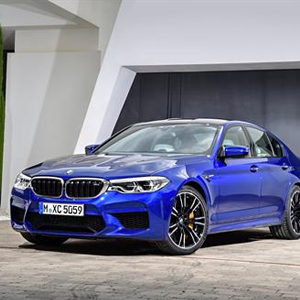
The electromechanical M Servotronic steering system provides the right steering torque for every driving situation. The new M5 has incredible turn-in, coupled to excellent steering feedback, yet in city and short-distance traffic it adapts to offer low steering forces during manoeuvring and parking.
The double crossbar axle, seen on the BMW 5 Series Saloon, was significantly revised for use in the M5. BMW M engineers have re-designed all components leading to even greater driving stability.
The five-bar rear axle has also been adapted to M-specific requirements. New steering systems with stiffer rubber pads also meet the increased demands on driving dynamics and steering precision, such as harder stabilisers and lower, stiffer anti-roll bars. The rear axle has an elastomer bearing, specially developed for the M5. An additional steel cross strut and an aluminium cross brace increase the stiffness of the rear axle and improve its response.
Also not visible from the outside, but still critical to the car’s handling, are other bodywork measures. For example, a domed aluminium front panel reinforces the front of the vehicle as well as the two front struts.
The tyres were developed especially for the M5 too, with 275/435 R20s at the front and 285/30 R20s at the rear. They are mounted on light-metal cast Double-spoke bicolour wheels. These wheels are also optionally available in Jet black.
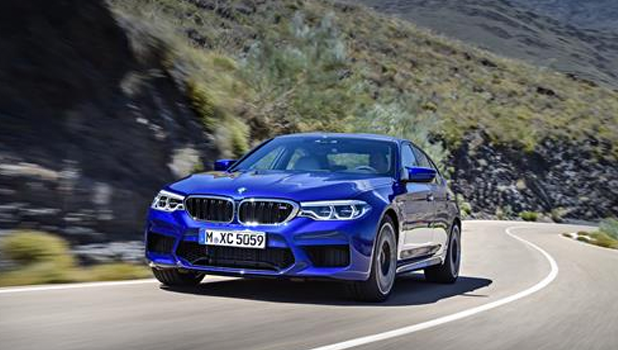
Brake pads have been developed using a special M compound, characterised by significantly lower weight compared to conventional cast iron brakes. At the front and rear, perforated and internally ventilated brake discs are mounted within blue-painted six-piston callipers with a distinctive M logo designation.
M Carbon ceramic brakes are also available as an option, distinguished by matt Gold-coloured callipers with M logo designation. These are 23kg, increasing driving dynamics and suspension comfort, among other things. BMW M Carbon ceramic brakes have even better performance, less fade and improved thermal stability.
Sporty design where form follows function.
The design of the new BMW M5 is specific to M. For example, the completely redesigned front bumper with its enlarged air openings has the task of supplying the cooling systems and brakes with sufficient cooling even in race track applications. The track width is greater than the car’s predecessor, the front wings are aluminium for weight reduction and carry characteristic M-sport cooling gills.
The bonnet is also made of aluminium, while the roof consists of a very light and stable carbon fibre reinforced plastic (CFRP) – the first time such an innovation has been used in a BMW M5.
The rear diffuser was also redesigned, while the M-specific rear apron and the M rear spoiler, coupled to purposeful sill panels, all enhance the sporty and powerful appearance of the M5. The exterior mirrors are also M-specific and designed dynamically. The hexagonal, central air intake is not only separate from the side air intakes, but also integrates the oil cooler – a beautiful combination of form and function.
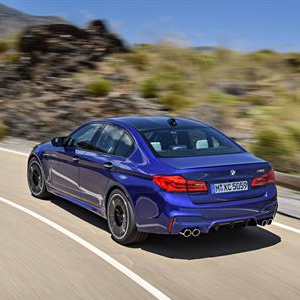
The interior focuses entirely on the driver. Absolute control under all driving conditions is the maxim. At the same time, the new M5 offers space for up to four passengers, a large boot and high levels of comfort akin to those of the 5-Series saloon, combining the best of both worlds as a high-performance sports car and business vehicle.
Equipment without compromise – The driver is the focus.
The M5 enjoys tremendous levels of standard equipment, all geared towards driving dynamics. The focal point is the driver’s seat, from which all switches and buttons can be operated in an ergonomically designed way.
All vehicle functions are located directly in the driver’s field of vision. The large digital display from the BMW 5-Series was reconfigured specifically for M. It informs the driver about dynamic modes, the all-wheel drive M xDrive and the Drivelogic setting. The speed warning alarm is adjustable and shift lights inform the driver when it is the optimal time to change gear in manual shift mode. The data can also be reflected in the head-up display.
Almost all of the dynamics systems can be configured via the central touch-screen display, centre console button and M-Sport steering wheel. The central information display also has a gesture control.
The M5 is now started with a red start button, marking out its sporting intentions, while two red lacquered buttons M1 and M2 next to the shift paddles on the M multifunction steering wheel control the driving settings, including xDrive and DSC, as well as engine, transmission, damper and steering characteristics, plus the head-up display.

The M multifunctional seats are now offered as standard and provide better support in the shoulder area. With its racing cup shape and the more pronounced side edges of seat and backrest, the M multifunctional seat offers even greater lateral support for keen drivers, with an illuminated M5 logo, finished in Fine grain Merino leather. The seats feature electric adjustment, seat heating, and a memory function. The seat depth can be electrically adjusted, along with the seat backrest width to offer the best lateral support to all shapes and sizes of driver.
The new M5 is available in a variety of exterior colours, some of which are exclusively reserved for the model. A brand new shade is Marina Bay blue metallic, an intense blue colour. Also available on request are matt colours such as Frozen Dark Silver or Frozen Arctic Grey.
In the best tradition.
For more than 30 years, the M5 has been the epitome of the ultimate sports saloon. Launched in 1984, it was always a car that hid its amazing sporting capabilities behind a discreet yet powerful exterior. The latest model embodies that spirit and takes it yet further.
1984: BMW M5 E28S.
The first generation M5 (Type E28S) was introduced in the autumn of 1984. It was powered by a 24-valve six-cylinder 3.5-litre engine with 286PS, from the mid-engined M1 sports car. The engine was equipped with a single-butterfly valve system and accelerated the first M5 from a standstill to 62mph in just 6.5 seconds with a top speed of 152mph. It was the fastest four-door production saloon of its time.
1988: BMW M5 E34S / E34 / 5S.
With the second generation M5, launched in 1988, BMW Motorsport GmbH once again created a hero. Its 3.6-litre engine developed 315PS and for the first time reached 155mph. In the second generation E34, the displacement increased to 3.8-litres and the output to 340PS. From 1992, a Touring version appeared, of which only 900 were made.
1998: BMW M5 E39S.
The third generation M5, the E39S, was as discreet as its predecessors. Underneath the bonnet, though, it packed a 5.0-litre 32-valve V8 engine, with an incredible 400PS sent through the rear wheels and 500Nm of torque. Top speed was limited to 155mph, with zero to 62mph in just 5.3 seconds.
2005: BMW M5 E60 / E61.
With the fourth generation M5, the E60, BMW developed a new 5.0-litre V10 engine with 507PS, delivered at an astonishing 7,750rpm. It did the zero to 62mph sprint in just 4.7 seconds and again was limited to 155mph. In some markets, the M5 driver was able to cancel the maximum speed limit with the new M Drivers Package – so the M5 went as fast as 189mph. Also new was the automated Sequential M Transmission (SMG) with seven gears and Launch Control for maximum acceleration.
2010: BMW M5 F10M.
The fifth generation BMW M5 came under the F10M type designation in 2011 and had the first generation of the current 4.4-litre V8-Biturbo. With 560PS, the performance had almost doubled that of the first M5. The 680Nm maximum torque also represented almost double (E28S: 340Nm). Thanks to M TwinPower Turbo technology, the M5 sprinted to 62mph in 4.3 seconds, via a new 7-speed M twin-clutch transmission. Its unrestricted top speed was 189mph.
In 2013 came the M5 with Competition Package, a variant with 575PS. In 2014, the special 30th anniversary model with 600PS came along, of which only 300 were built.
2017: BMW M5 F90.
With the new BMW M5 (Type F90), BMW M is continuing a success story that began over 30 years ago and is based on a seemingly simple recipe: luxury through the highest level of performance and comfort.


